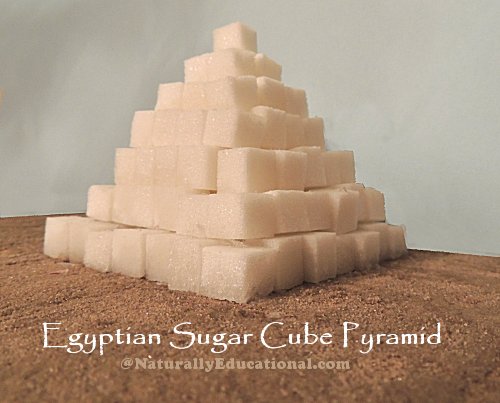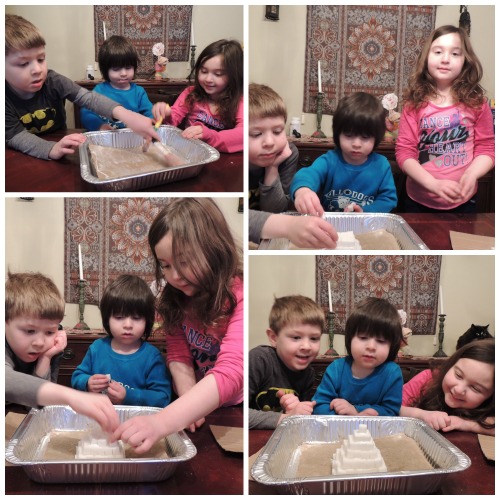My children and I tried two methods to build pyramids as part of our study of Ancient Egypt. The first is the sugar cube pyramid.

We’ve been continuing with our World History lessons but I have not had much time to post. We moved on from prehistory to the dawn of civilization: Ancient Egypt and Ancient Mesopotamia. For those who are also using The Story of the World, I find the strict chronological approach involves a lot of bouncing around. My preference would be to study all of Ancient Egypt, up until Roman rule, in one unit. Since this is the first time we are using this curriculum, however, I am following along.
My kids are absolutely obsessed with Ancient Egypt, especially my son who likes to draw complex pyramid-building and mummification scenes.
The process is simple enough that even the toddler could join in. First, we coated a piece of cardboard with glue and covered it with craft sand.
(Note: The project is in a roasting pan to limit the mess from the sand. This precaution was entirely negated by the fact that my toddler overturned the roasting pan after the project’s completion, then overturned the dustpan I used to clean it up while I moved the project, then dumped the entire canister of craft sand on the ground while I tried to clean that up, then finally emptied out the remaining contents of the sugar cube box while I swept that up.)
First, we calculated how big our base could be with the amount of sugar cubes we had. We had a box of 198 cubes so we went with a base of 7 x 7.
We glued seven rows of seven cubes together and then added glue on top of that, placing six rows of six cubes. We continued reducing each side by one cube until we reach a single cube on top.
We used glue, which kept getting absorbed into the sugar cubes. We probably would have been better off using icing as the mortar.
The result is more of a step pyramid like the Pyramid of Djoser, rather than a smooth sided pyramid.
We left the pyramid white as the pyramids would have been faced with white limestone.

Educational Connections:
- Social Studies / History: Why did the Egyptians built the pyramids?
- Architecture: In what ways is your sugar cube pyramid similar to the pyramids of Egypt? In what ways is it different?
- Engineering: How did the Egyptians build the pyramids? There are a number of theories but no one knows for sure!
- Mathematics: How many cubes did you use in your pyramid (we used 140)? How many blocks are used in some of the pyramids of Egypt (about 2.3 million in the Great Pyramid of Giza)?
—
Because I am a social studies educator and the topic seems to be getting short shrift in the current push for test scores, I am following the The Story of the World: History for the Classical Child: Volume 1: Ancient Times: From the Earliest Nomads to the Last Roman Emperor, Revised Edition to introduce my children to Ancient History and supplementing with outside texts and activities. My school-aged children attend school and so this is an “after-schooling” project for us.




This is a fun, hands-on way to learn about building the pyramids. Unfortunate that your keep-it-less-messy ideas didn’t work though! 😉
Love this idea! We are learning about ancient Egypt in my co-op, I think this will be perfect 🙂